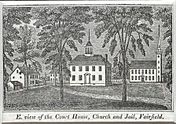Burning of Fairfield (1779) facts for kids
Quick facts for kids Burning of Fairfield
|
|||||||
|---|---|---|---|---|---|---|---|
| Part of the American Revolutionary War and Tryon's raid | |||||||
|
|||||||
| Belligerents | |||||||
| Commanders and leaders | |||||||
| Captain Levi Stone | William Tryon George Garth |
||||||
| Strength | |||||||
| Fairfield Militia | 800 (Initial Landing Force) 1,700 (Reinforcements under Garth) |
||||||
| Casualties and losses | |||||||
| 10 Killed 2 Wounded 6 Captured |
11 Killed 44 Wounded 6 MIA |
||||||
The Burning of Fairfield was a big event during the American Revolutionary War. It happened in Fairfield, Connecticut, on July 7, 1779. A British army, led by General William Tryon, attacked the town. They fought and defeated the local American militia. After the fight, the British burned almost all the buildings in Fairfield.
Why Fairfield Was Attacked
The attack on Fairfield was part of a larger British plan. This plan was called Tryon's raid. About 2,600 British soldiers launched this attack. They came from their base in Long Island. Their goal was to punish towns in Fairfield and New Haven counties. At that time, Fairfield and the areas around it were known for strongly supporting the American Revolution.
The Attack on Fairfield
On the morning of July 7, the British ships were seen. Coast guard militia at Fort Black Rock quickly warned the town. A few hours later, General Tryon and his first group of 800 soldiers landed. They came ashore at Compo Beach. This area is now part of Westport.
The British soldiers then marched inland towards Fairfield. The local militia fought bravely for a short time. However, the British soon took control of the town. They then began to destroy it. After the first attack, Tryon's forces got more help. Another 1,700 soldiers arrived. These reinforcements were led by General George Garth.
Remembering the Burning
For many years after the burning, people in Fairfield have remembered this event. With help from the Historical Society, they put on special re-creations. They also offer guided tours. These tours show where the British soldiers moved on that day. They also highlight the few buildings that survived the attack.


